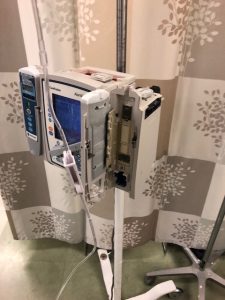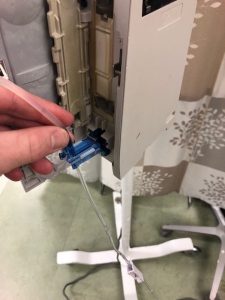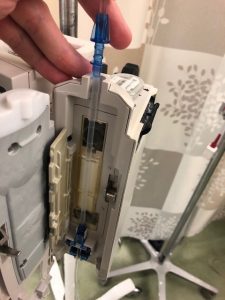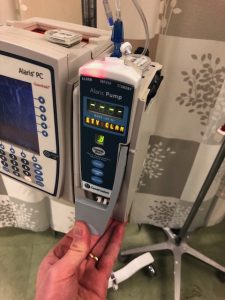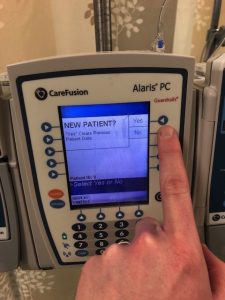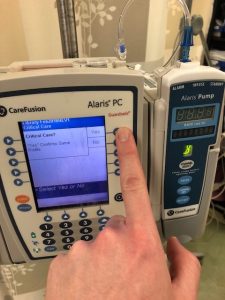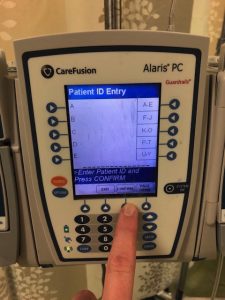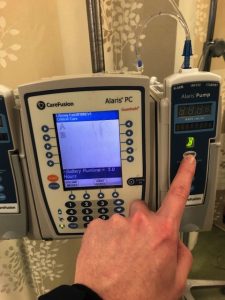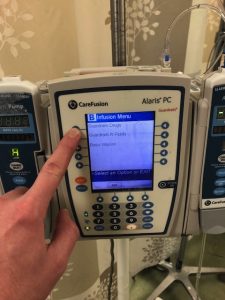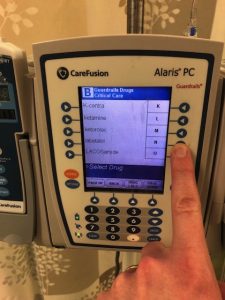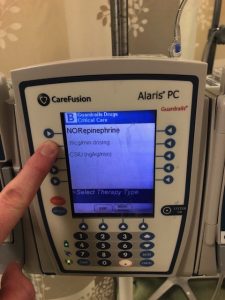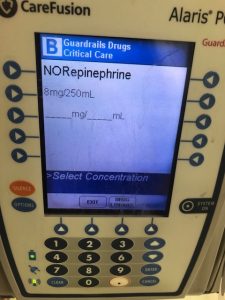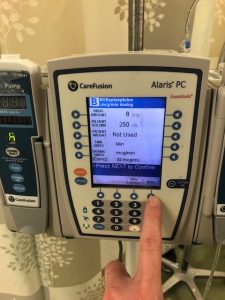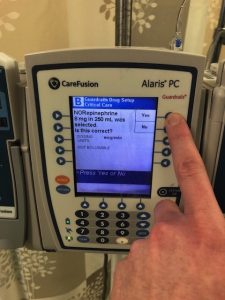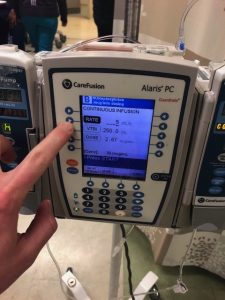CAUTION
Messing with a pump is an easy way to draw the ire of your nursing colleagues. There are ways to mess this up, and every change in rate needs to be charted. If you’re going to start a drip or change a drip rate, make sure you are communicating clearly with the nurse caring for the patient. With that said, it’s productive to at least have an understanding of what your nursing colleagues are doing with these mystery pumps. Moreover, if you are the sole provider with an unstable patient in CT who needs a the rate of a vasopressor infusion increased, you should be able to make that happen.
Here goes.
(1) Flush the line (fluid should drip out the end), then shut the line down (so the medication doesn’t drip everywhere)
(2) Put the cartridge into the pump (cartridge needs to be put together to fit)
(3) The blue plastic piece at the interface of the regular tubing and the fogged tubing (for inside the pump) needs to be outside the pump
(4) Close the pump. Once the pump is closed you can open the line back up (white roller distal to the pump open)
(5) Press “system on,” and then select “Yes” at the “New Patient?” screen
(6) Select “Yes” to “Critical Care” (all of the medications you might infuse become available)
(7) Hit “confirm” at the bottom of the screen (you don’t need to add a patient ID)
(8) The machine will prompt you to select the channel you’re using. Click “channel select” on the channel itself
(9) Now, you want to pull up the list of infusions. Select “Drugs.” Unless you want fluids.
(10) Surf through the alphabetized list of medications. In this case, we’ll use norepinephrine.
(11) Select mcg/min dosing. That’s what we use. Anesthesia, CSICU sometimes use different units.
(12) Select 8mg/250 mL (this is our standard concentration)
#pearlinapearl
The “quick epi drip” can been used to great effect in the crashing, hypotensive patient. There are a bunch of ways to accomplish creating a quick epi drip. The method I was first introduced to is to put 1 mg/10 mL stick of “code dose” epi in 1000 mL normal saline (1mcg/mL). There is no doubt this is the fastest way to make a safe, diluted epi drip for a crashing patient. Recently, I’ve started putting 2 of the 1mg/10mL sticks of epi into a 250mL bag (of whatever). This is 8 mcg/mL. You have to run this slower than the 1mcg/mL formulation of quick epi, but that’s okay (titrate to the arterial line tracing). Because our standard epi drips are 16 mcg/mL, the 8 mcg/mL can be put into the pump. If you are using these Alaris smart pumps, just put 2mg/250mL into the concentration at this screen. If you’re using a less-smart pump with an associated drip sheet (see: Elmhurst)just double the rate required for a given dose.
(14) Plug in the volume to be infused, and your desired rate
(15) Verify your rate/volume to be infused
(16) All set, you are infusing
Next, we’ll go through the steps to change the infusion rate. Again, proceed with caution, talk to the nurses
(1) Select the channel of the medication you want to change the rate of (“channel select” on the physical channel)
(2) Change the rate
Huge thanks to my nursing colleagues who, against their better judgement, walked me through this process today.
